
Reconfigurable vehicles
Karen Parnell, European marketing manager high volume products, Xilinx
Ref: z2511082m
(Article provided by Avnet Kopp, 011 444 2333, [email protected])
This article will focus on how Xilinx enables the automobile to be a more entertaining, more informative, and a more productive environment. When we envisage automotive electronics we automatically consider electric windows, central locking systems, safety systems, climate control and electronic ignition systems, all of which require stringent qualification, temperature cycling, and certification. The new emerging automotive electronics boon has now shifted from under the hood or bonnet to in-cabin multimedia applications. The trend towards mobile offices and entertainment on the move has meant a large portion of the electronic or semiconductor content has moved into this expanding area.
Introduction
Car manufacturers are striving to differentiate themselves from their competitors by offering high tech infotainment items such as GPS navigation, DVD players, and incar PCs. In this paper, we will explore new market trends in automotive applications and consider how consumers are driving the need for enhanced telematics and more comprehensive infotainment. We will then move on to look at the differences in the qualification for in-cabin components versus those in the harsher under bonnet/hood environment. Finally we will look at actual application examples and how Xilinx Field Programmable Gate Arrays (FPGAs) and Complex Programmable Logic Devices (CPLDs) are helping to change the way we think about automotive designs and how they reduce time to market in this new era of fast moving in-cabin automotive electronics. Figure 1 shows both where electronic systems are present in the average vehicle and highlights those areas where Xilinx devices can be used.
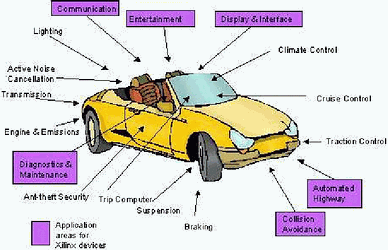
We will be concentrating on how Xilinx can enable the automobile to be a more entertaining, informative, and a more productive environment. Increasing the amount of information and entertainment provided within a car is not without limitation or restriction; we are now seeing the automotive governing bodies introducing user guidelines. For example, the European Union and several US states are considering prohibiting the use of cell phones while driving. An alternative solution would rely on speech recognition for dialling instruction. Global positioning systems (GPS) radio frequency (RF) or smartcard technologies are being explored and implemented for electronic toll collection in order to reduce congestion. These hot new features are driven by consumer demand, vehicle manufacturers trying to differentiate themselves from their competitors but also by governments around the world dedicating resources to researching and developing ways to address safety concerns. This momentum creates a favourable environment for deploying more electronics into vehicles.
Due to time to market and cost pressures, the increased electronics content can only be achieved by integrating electronics with electrical and mechanical systems. Additionally, car manufacturers are increasingly reliant on independent electronics system suppliers or third party suppliers to provide these new functions. The third party suppliers have to produce a different model of system for each different OEM. This leads to different PCBs, new front displays and mouldings, different connectors and wiring, and dedicated software. The trend, therefore, for these third party suppliers is to base every model they produce on a common platform which can be 'tweaked' through minimal changes for each OEM. This has lead to programmable logic not only being used for prototyping systems but being also used in full production to allow for system personalization. Motorists and 'early adopters' through the booming after market are already using many of these new technologies. These after market products such as GPS navigation units, in-car TV systems, and DVD players are fitted after the car has been manufactured.
Figure 2 shows some of the emerging 'semiconductor rich' products that will become part of the standard options available in vehicles over the next few years. These features will also be offered as after market products that can be fitted after the car has been delivered to the end customer.
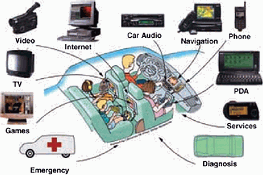
Xilinx devices
In the digital world, there are two types of electronic chips: memory and logic. Memory chips are used to store information. Logic chips are used to manipulate, or interface with, the information contained in memory. Programmable Logic Devices (PLDs) are 'off the shelf' logic chips that the customer, rather than the chip manufacturer, programs to perform a specific function. With the ability to program their own chips, customers realize two key benefits: product design flexibility and faster time to market. With today's shorter product life cycles, both of these factors can be critical determinants of a product's ultimate success.
Electronic equipment manufacturers rely upon PLDs to make fast design changes, accommodate uncertain production volumes, and accelerate their product's introduction to the marketplace.
In the future, it is expected that programmable logic technology will play a larger role in automotive applications. This will come as a result of its ability to provide advanced network centric features, such as Xilinx Internet reconfigurable logic (IRL). By using IRL, the automotive manufacturers can build-in upgradeability and reduce risks. For example, you can upgrade or enhance the performance of your car for the weekend by paying for your engine management system to be 'race' tuned to enhance the performance of your car. This will give you the ability to purchase a 'racing car' for the weekend in your standard family vehicle. The reconfigurable logic-based engine management system would be reprogrammed via a wireless Internet connection to change the car's 'personality' and at the end of the prepaid time period reprogrammed back to its original settings.
Xilinx high-volume field programmable gate array (FPGA) and complex programmable logic devices (CPLD) provide system designers with cost-effective solutions that retain the traditional PLD time to market advantage. Today, Xilinx programmable logic devices are employed by a large number of telematic and infotainment product manufacturers, who recognise the added flexibility and time to market benefits achievable through the use of programmable logic solutions.
Telematics and Infotainment
The intelligent vehicles market offers a new breed of automotive engineering and a whole new world of electronics systems, computer, and software applications. These systems applied to vehicles will affect the vehicle in three basic functional areas: the basic vehicle, safety/security, and telematics (the merging of communications and computing technology to provide driver information, communications and entertainment). Below are some of the features the next generation of vehicle will have as standard equipment, all of which are encompassed in telematics or infotainment systems:
* Navigation and route guidance.
* Realtime information (traffic, news, business directories, Internet/e-mail).
* Entertainment (broadcast, onboard).
* Automated transactions (tolls, purchases).
* Position reporting (via GPS).
* Communications (broadcast, two way).
* Stored onboard information databases.
* Services on demand (voice activated systems, vehicle tracking, and recovery).
Auto-industry participants also use the term 'infotainment' to describe devices such as stereo systems, navigation systems, cellphones, and others. Figure 3 shows the huge growth in car navigation, multimedia, and emergency only systems, this market is predicted to grow from just over 2 million units in 1999 to over 12 million units in 2004.
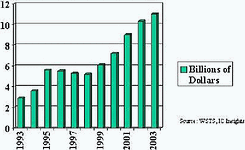
Figure 4 shows the elements that make up a typical infotainment system. These functional blocks are:
* Global positioning system and GSM wireless receiver.
* Digital radio (digital audio broadcast - DAB decoder and analog to digital converter - ADC).
* Television.
* Audio entertainment units such as tape, CD, and MP3 player.
* Digital versatile disk (DVD) player.
* Graphics controller to interface to the in-car display for entertainment (eg, games console) for the passengers and information for the driver.
* Sound system controller for audio front and rear.
* Digital signal processing (DSP) for processing sensor and gyro data and for processing the digital audio and video.
* CODEC for coding and decoding audio to and from the man machine interface (MMI), eg, voice recognition system.
Xilinx devices can be used to perform the interfacing functions between the main functional blocks. Most of the functions can be considered as chipset glue logic, memory decoders, and interfacing logic. We will study each functional block in Figure 4 that could potentially contain Xilinx programmable logic:
1. GPS receiver - Programmable logic can be used as part of the GPS receiver to process the output from a GPS chipset and format it for the microprocessor being used in the system
2. Gyros and sensors - Xilinx devices are ideal for high-speed digital signal processing and signal conditioning on the outputs from sensors and gyros. The processing may not need to be exceedingly fast, but where programmable logic could add benefit is if there are multiple channels to process. Multiple channels even at a slow data rate can equate to high digital signal processing (DSP) multiply and accumulate (MACs) operations. Where DSP MAC operations are in the billions per second offloading this process from a standard digital signal processor to an FPGA may be beneficial. A common DSP function is a filter and the more MAC operations that are applied to the incoming signal, the higher the accuracy of the filter. The latest Virtex-II FPGAs from Xilinx can perform 600 billion MACs per second.
3. Digital audio broadcast (DAB) - Xilinx high-density FPGAs, such as Virtex devices, have been instrumental in bringing this technology into the vehicle by providing a reprogrammable platform for research and design proving. In this design-proving phase, FPGAs were used to perform the main DSP functions. As the technology has matured, these functions have been integrated into application specific standard product (ASSPs) and standard chipsets to reduce costs by reducing redundancy. We are now seeing Xilinx low-cost FPGAs and CPLDS, such as Spartan-II, XC9500, and CoolRunner devices, being used as the 'glue logic' between these chipsets.
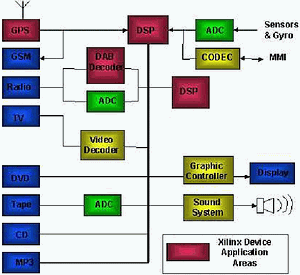
Multimedia platform
As more and more information and entertainment systems are added to automobiles, we are seeing the inevitable conflict of digital standards and protocols. A bewildering array of emerging standards and protocols are being tried and tested for use in the latest in-car systems. These new standards and protocols include: Bluetooth, BlueCAN, MP3, Java, AutoPC, AMIC (Automotive Multimedia Interface Consortium with JINI interface), WAP (wireless application protocol), HTML, XML, MOST (Media Oriented System Transport), FireWire, CAN (controller area network), TCP/IP, and more - but which one(s) will prevail?
Overcoming the design challenges
Designers of the new wave in-car multimedia systems must include traffic information systems, Internet/web access, electronic game consoles, mpeg music download capability, digital radio reception, and mobile commerce services. They must also have the flexibility to provide all or just a few of these functions. Other challenges faced by the designers are:
* Small physical space available to place these products in the dash or seat backs.
* Low cost units that can fit into more than one model of car.
* Aesthetically pleasing look and feel.
* Ease of driver use.
* The ability to upgrade the unit when automotive standards change.
Designers must now also ensure that the in-car multimedia system can 'talk' to the other devices introduced into the cabin space. For example, if a mobile phone is brought into the car environment, it should be automatically detected and able to communicate with the car's communications network. This automatic connectivity could also include connection of PDAs, portable PCs, MP3 players, and other personal portable electronic equipment to provide a truly connected and functional in-car environment.
Some 'after market' product manufacturers have provided short-term solutions to some of these problems by producing audio systems based around MP3 technology. When in the cabin, the MP3 player is seated in the car audio system, but when you leave the vehicle it can be removed to become a handheld portable MP3 player.
The new way of designing
As in-car and consumer functions converge - and new automotive and consumer standards and protocols emerge - manufacturers are starting to prototype multimedia platforms that can provide as much, or as little functionality, as required. Such multimedia platforms can be best realised by designing reconfigurable hardware.
Reconfigurable hardware can be programmed late in the production flow to provide custom functionality on a 'standard' hardware platform - and can also be configured to accommodate new and emerging in-car standards.
Figure 5 shows the automotive multimedia platform design approach. This concept will also allow hardware upgrades throughout the lifetime of the car - these upgrades can be implemented remotely by using the wireless communications/Internet connectivity provided by the unit. Xilinx terms this remote hardware upgrading process 'Internet reconfigurable logic (IRL) via the Xilinx Online program'.
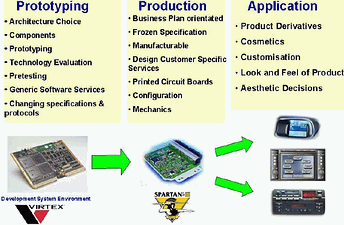
The Xilinx Online program is designed to enable, identify, and promote network upgradable systems, hence 'future proofing' a system and avoiding product obsolescence. These are systems that can be upgraded, modified, or fixed long after they have been deployed in the field. While many designers have been building upgradable devices based on Xilinx technology for years, the explosion of networked devices has dramatically increased the demand for these user configurable and adaptable applications. For example, an engineer can use the existing wireless communications/Internet infrastructure to reprogram an in-car multimedia system to include extra functionality such as adding an MP3 player or upgrading the system to take advantage of the latest protocol or standard.
Multimedia system design flow using FPGAs
The multimedia platform ideally should be based around one human machine interface (HMI) to allow for all functions to be accessed via one colour menu-driven touch screen. As the functions are implemented in software and reconfigurable hardware, the system can be upgraded even after the car has been purchased and driven away.
The new way of developing in-car systems is to prototype using FPGAs in a generic development environment. The elements can then be developed quickly and easily without the need to fix specifications. This initial prototyping phase can be realised using Virtex-II Platform FPGAs. At this early stage, the different standards, protocols, and functions can be tried, tested, and debugged utilising the headroom that a large FPGA gives.
As the design firms up, the specifications are 'chilled' or 'frozen', and the boards are 'productionised'. In other words, the specific standard, protocol, or function is chosen from the many tested. This move from prototype to production enables the design to be optimised and fitted into a smaller, low-cost FPGA, such as a device from the Spartan-IIE family, while still allowing for system upgradability. Once in production, the FPGA can be used to aid total printed circuit board (PCB) testing using JTAG techniques. If necessary, designs can be 'tweaked' or enhanced at this stage. The final stage is the look and feel or aesthetics of the product, which can be designed for each car manufacturer to fit into their specific dashboard (or fascia). All of the production multimedia units are built up around the standard FPGA-based platform. This standard platform can be programmed with its 'personality' late in the production flow to accommodate last-minute design changes, or end-user preferences.
Having a common platform reduces inventory and takes advantage of the cost saving associated with producing one platform for all units. The benefits of using this reconfigurable hardware-based multimedia platform approach are:
8 Easier control of software and hardware development.
* Re-use of components, be they software or hardware (design re-use).
* Increase in the time developers can spend on creating value as opposed to creating system interconnect structures.
* Reduction of risk through clearer understanding of the basic components.
* Choice of standard or protocol can be deferred and simply reconfigured.
* Increased productivity through the application of modern development tools.
* Increased openness of the system, supporting the use of standards and integration of third-party components.
The Xilinx in-car multimedia solution
We predict the heart of the reconfigurable multimedia platform will be a Xilinx programmable logic device. The common platform approach enables one PCB to be produced for all customers - with the only change being to the style, shape, and colour of the interface to satisfy the need for product differentiation.
Xilinx is the leading provider of complete and innovative programmable logic solutions. Our products help minimise risks for manufacturers of in-car electronic equipment by shortening the time required to develop products and in taking them to market. You can design and verify your proprietary circuits in Xilinx PLDs (programmable logic devices) much faster than you could by using traditional methods, such as ASICs and ASSPs. Xilinx builds programmable ICs, develops software, IP (intellectual property) cores, and other tools to provide complete solutions to our customers. We also provide application support and design services to customers developing their own proprietary designs.
To 'drive' the in-car digital convergence revolution, Xilinx recommends the Spartan-II FPGA family and the CoolRunner and 9500XV CPLD families. The Xilinx CPLD families are qualified to the automotive temperature range parameters. The Spartan-IIE FPGA family is based on the very popular Virtex family. Spartan-IIE extends the legacy of the Spartan series, with more gates, better performance, and enhanced features. The Spartan-IIE family offers digital delay locked loops, programmable I/Os, on-chip block memory, and densities up to 300 000 system gates.
These features and densities, coupled with enhancements to software and an increased number of available IP cores, provide a reduced time-to-market and increased time-in-market at a much lower cost. Xilinx also has a range of IP cores such as memory controllers, system interfaces, DSP, communications, networking, and microprocessors.
Digital radio
Digital audio broadcast (DAB), radio data broadcasting systems (RDS), and the traffic message channel (TMC) are set to change car stereo systems as we are witnessing massive innovations toward telematic applications. Until recently, analog radio signals, such as FM, have been subject to numerous kinds of interference between the transmitter and the radio. Mountains, high rise buildings, and atmospheric conditions can cause these problems. DAB uses these effects as a reflector creating multipath reception conditions to optimise receiver sensitivity. Since DAB always selects the strongest regional transmitter automatically, the in-car receiver will always be the focal point of incoming radio signals. DAB is broadcast on terrestrial networks and is received using a small nondirectional stub antenna. The reception is CD-like quality without the annoying interference or signal distortion. DAB is not only able to carry audio but can also carry text, pictures, data and video. In this application, time to market and price is a key factor when selecting components to perform such tasks as decoding the incoming data stream. Xilinx CPLDs are an ideal fit in this product as they are low cost and easy to design with. By completing a design in the Xilinx WebPACK, software designs can be input, simulated, and programmed into a device in a matter of hours.
Passenger entertainment and on-board interactive information systems are just around the corner. Newer vehicles will have multiple display terminals, and personal audio sets will become available for passengers.
Although DAB/RDS systems are starting to be very popular in Europe, they are not in demand yet in other regions. Video and gaming systems are starting to ship in significant numbers in Japan, but not in other regions yet.
These new multimedia products are thought to have the effect of entertaining passengers and reducing driver interruption, allowing these solutions to be marketed as new entertainment, convenience, and safety systems. Some of the latest technologies, such as DVD (digital versatile disk), are already finding their way into the in-car entertainment market. DVD players are replacing CD-ROM (compact disk - read only memory) players in car navigation systems, mostly being used to replay prerecorded video, interactive video games, and other such high-density software titles. The evolution of in-car entertainment continues at the same pace as development in consumer entertainment markets.
Motorola has designed and developed a new in-car Internet radio prototype called iRadio, a revolutionary concept for in-vehicle information and entertainment via wireless Web access.
iRadio will enable drivers to capture music on demand, listen to realtime traffic reports, download audio books, access voicemail, receive the latest news and weather reports, get updated stock portfolio information, and access e-mail. These off-board mobile multimedia features will be delivered wirelessly via Web access, satellite, digital cellular, and FM sideband technologies.
A number of infotainment system manufactures are designing multimedia platforms (MMPs) that integrate functions such as DVD, DAB radio, MP3 player, and other functions. The MMP is a building block for future enhancements and technological advancements for in-car infotainment. Many of these platforms are based on FPGA technology to allow for future growth and enhancements and also accommodate new standards and interfaces. These platforms have the potential to be updated and upgraded in situe to provide new emerging audio and visual pleasures such as MP3 audio.
Car driver assistance
Car safety is one of the primary concerns in the automotive industry and we have seen over the years the addition of airbags, seat belt pre-tensioners, side impact beams, and other structural enhancements. We are now seeing the emergence of car driver assistance systems to augment the more 'physical' safety enhancements. The latest car driver assistance system is based around a video processing system located in the rear view mirror and dashboard of the vehicle. The system processes data from both inside and outside the car. It analyses erratic road movements or leaving the lane if the driver has fallen asleep and automatically corrects and brings the car to a gentle stop. The system also analyses outside light levels compared to road conditions, such as curves, and adjusts the headlamp luminosity and direction accordingly. This driver assistance system also measures distance to the car in front and if an accident is imminent it will ensure activation of the airbag systems. The distance sensors can also aid when parking your vehicle. Xilinx FPGAs are ideal for implementing complex imaging and DSP functions and have been used in car driver assistance systems. Choosing how large your hard-drive, how much RAM you require may soon be as common as choosing what colour your vehicle will be in the list of car options. It is predicted that the AutoPC will become an integral part of the make up of your vehicle by integrating all audio, visual, Internet connection, cellphone, and navigation functions into one small PC; which will fit into the dashboard where the typical car radio usually fits.
Auto PCs
This addition to the average family car will enable an office on the move along with playing DVDs for the rear passengers and downloading the latest MP3 file to pipe through to your car speakers. This addition will allow you to purchase items advertised on the radio by reading your credit card details and authenticating it via the dash mounted smartcard reader, dialling up the appropriate website from details provided by the RDS function of your radio, and then transacting an on-line purchase via wireless Internet connection.
Internet traffic is doubling every 100 days so it is conceivable to imagine this technology migrating to standard in-car equipment very soon. At Visteon, Ford's auto electronic business, a Pentium and Microsoft CE-based Information; Communications, Entertainment, and Safety (ICES) platform contains numerous features. It includes a CD player for audio, a DVD player for movies (displayed via a LCD screen), a cellular telephone, Internet access for e-mail and information, and a global positioning system. The company plans to add MMX features in its second generation system. For safety purposes and to keep the driver's attention on the road all system commands are voice-activated.
A similar system was developed at GM's Delphi subsidiary. GM worked closely with IBM, Sun Microsystems, and Netscape to come up with a system that offers essentially the same tools and features as the Visteon unit. GM and IBM took the client-server approach in their system development. In a prototype, the car (client) was connected to a satellite, which provided access to the Internet and geographic positioning. Data was beamed at a rate of 400 K-baud from a satellite to an antenna built into the roof of the test car. Digital audio from an Internet broadcast was beamed at the rate of 80 K-baud, producing CD-quality sound.
IBM also is working on a system for Mercedes-Benz in which an embedded PowerPC chip performs as a server, and other electronic systems - climate control, entertainment, information, and communication units - are the clients.
Typical services offered are:
* Entertainment - audio CDs, DVDs, games, etc.
* Communications - Internet access, cellular phone, GPS navigation, IR link to PDA/laptop
* Information - news, weather, traffic, e-mail, engine diagnosis, etc.
* Navigation - route finder, map, etc.
All under voice control, commands given verbally and feedback from the unit in digitised voice.
Some of the major in-car audio system designers are producing their own version of the AutoPC that fit into the dashboard. These multifunctional in-dash systems are available as aftermarket products, but will be installed as standard or optional features in high-end vehicles beginning in late-2001 or 2002. As the price of electronic systems declines, they will be placed in mid-priced cars and eventually, all vehicles.
Because the AutoPC is designed to fit into the space usually occupied by the standard audio system the electronic design has to be highly integrated. Many manufacturers of these products are looking to system-on-a-chip technology but with short time-scales to meet consumer demand. FPGAs lend themselves very well to this environment having the ability to absorb interface logic, decoding, encoding, and digital signal processing (DSP) functions. Ball grid array (BGA) packaging techniques allows many millions of system gates to occupy very little space on a printed circuit board (PCB). FPGAs can offer a great advantage over ASIC equivalents by reducing time to market and can by upgraded in-dash using Internet reconfigurable logic (IRL). IRL can be used to great advantage in this fast moving area as the Internet connection is already there in the AutoPC. If the hardware needs to be upgraded to implement new functions or standards, then this is achieved by Internet-based FPGA reconfiguring.
Navigation and global positioning systems
Navigation semiconductor content is the third fastest growing sector - in fact, it is predicted to reach the same growth rate in terms of semiconductor consumption as the consumer market place by 2001 (according to Dataquest figures).
GPS technology offers immense capabilities for navigation systems with its accurate location tracking systems. The accuracy of the location systems also make them very suitable for vehicle tracking applications, and these systems have therefore been designed into fleet control and car security systems. While GPS is widely used in Japan for navigation systems, in the United States, roadside assistance and emergency calling are expected to drive the first wave of GPS use in cars. Table 1 illustrates some GPS applications.
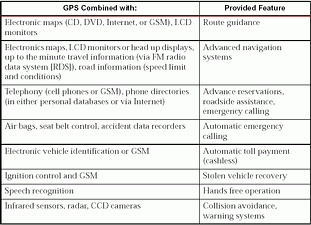
GPS lets you and your car know exactly where you are at any time; this can be used for:
* Geographic-based advertising.
* Fleet car management.
* Toll road direct billing.
* Automatic emergency calls.
* Route finding and mapping.
As you are driving and listening to your favourite digital radio station and the advertising break is reached, a personalised geographic-based advert could be played to you. For example, if you are driving past a restaurant, you could be offered money off meals or told about the latest meal deal. Estate agents, hotels, and car dealerships could use this adverting technique (especially if they receive information from your car about its make and model as you pass), basically, it can be used by any merchant you drive past to advertise and inform.
GPS could also be used to track fleet vehicles so that the fleet manager knows the exact location of each vehicle and where they have travelled. This information could be useful for planning more efficient routes and also diverting vehicles if there is an accident or roadworks.
Volkswagen plans to produce future versions of its Passat model with a built-in server that will let owner's track the location of their car and analyse its services and maintenance records using GPS and wireless Internet connection.
Multimedia data bus
Today's vehicles contain hundreds of circuits, sensors, and other electrical components. Communication among these electronic modules is usually handled via a dedicated wire through point-to-point connections. If all possible combinations of switches, sensors, motors, and other electrical devices in fully featured vehicles are accumulated; the resulting number of connections and dedicated wiring is enormous. Multiplexing systems together (in other words, putting the systems on a network) is more efficient for today's complex in-vehicle communications. Multiplexing technologies are networked cabling and communications techniques designed to eliminate the multiplicity of wiring found in the typical vehicle, brought on by the proliferation of electronic systems.
In Europe, the controller area network (CAN) bus has been used to connect the vehicle sensors and safety systems. CAN has been used to implement car busses to reduce wiring loom size, weight, and cost and also provide a standard serial bus that can be used to connect devices from many third party suppliers that make up the total vehicle. As more and more electronic equipment is added to the average vehicle, more and more wiring has been added. CAN offers the ability to reduce the amount of wiring in the car using multiplexing techniques. Multiplexing is a method for transferring data among distributed electronics modules via a serial data bus. The emerging intelligent transport system (ITS) data bus could allow communication among audio, video, and computing devices. A gateway could transfer required diagnostic information among the multiple networks. Figure 6 illustrates how networks may be configured in the future.
Because ITS products are considered 'consumer' items, a widely open ITS data bus standard is critical. An open ITS data bus would allow consumers to select products and features for their vehicles in much the same way as they select their home audio/video equipment. This development would enable a larger market and probably more rapid adoption rates, as ITS products designed to the standard could potentially be used in any vehicle. Also, with a standard bus architecture, manufacturers could use a colour LCD display not only for route guidance and maps, but also for emergency call service, environmental control, personal calendar, phone directory, and ultimately as a 'PC' monitor.
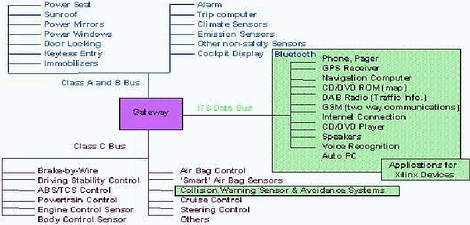
Bluetooth, meanwhile, is working on a wireless scheme to connect PCs, cellphones, pagers, PDAs, and other devices for data sharing. Bluetooth in a vehicle could be the easiest way for an occupant to link a handheld computer or an external network via a cellphone to the ITS data bus (IDB) through a wireless gateway. Using a Bluetooth connection allows for short range (less than 10 m) wireless connection of many devices in a small area. This would facilitate hands free cellphone operation without the need for mechanical contact and speaker and headphone reception without wires! Xilinx programmable logic devices have been used in Bluetooth application areas such as screen phones and prototyping PSTN networks for home use. Further details about Xilinx and Bluetooth can be found at the emerging Standards and Protocols (eSP) web portal (www.xilinx.com/esp).
Other standards the Telematics Suppliers Consortium (TSC) may pursue could link cars to cars, cars to road infrastructure, or cars to services at businesses, such as fuel stations. TSC foresees a day when you can pull up to the fuel pump and download a digital movie or e-mail over a short range wireless link while you fill up your tank.
CAN intellectual property
As we have seen CAN is the dominant automotive data bus in European cars and is being evaluated by the US automotive sector. The functionality of the CAN interface can be embedded within Xilinx FPGAs by using an 'off the shelf' core also known as intellectual property (IP) cores.
Xilinx offers the industry's largest selection of intellectual property (IP) cores, which serves as the foundation for accomplishing complex system-on-a-chip designs. Xilinx cores are predefined, tested, and verified to ensure correct functionality. In addition, Xilinx cores utilise Smart-IP technology to predetermine the implementation providing optimal and predictable performance and utilisation. The broadest selection of industry-standard solutions offered by Xilinx comprise two IP sources: LogiCORE and AllianceCORE. The LogiCORE program being the most successful in the industry offers cores exclusively for Xilinx FPGAs. These cores are sold and supported by Xilinx. The AllianceCORE program provides a broad selection of third-party cores customised for use with Xilinx FPGAs and CPLDs.
The need for design re-use has been apparent for many years; no company likes to put many man-years of effort into a design that can be used only once. Today, thousands of designers are creating intellectual property (IP) on a huge scale, targeting the widely popular Xilinx FPGA families, which are ideally suited to support design re-use. The AllianceCORE CAN bus interface (R3.0) from Sci-worx can be used in many automotive applications. This core can be embedded in an FPGA which can perform the CAN2.0B interface functions and also integrate discrete logic and other functions in one reconfigurable device.
Conclusion
We have seen that there are a number of factors effecting the way vehicles are evolving, consumer demand for a safer more entertaining, and a productive in-car environment. Government legislation has also been dictating items such as voice recognition systems for hands free device operation and emerging in-car bussing standards.
Consumers are demanding home comforts on the move such as DVD players, Internet access digital radio reception, and constant telephony services. In-car bussing systems have been developed to decrease the amount and, hence, the cost of wiring in the car and also to allow interfacing to equipment from third party sources. Changing international standards for in-car busses are driving the need for reconfigurable test and diagnostic equipment, which can be transformed to suit any bus standard. All of these factors are increasing the in-cabin semiconductor content. We are also seeing the time to market pressure reducing car cycles times from five years down to two years. Time to market pressures can be elevated by using programmable logic by providing shorter development time scales over traditionally used ASICs.
Xilinx high-volume FPGA and CPLD devices provide system designers with cost-effective solutions that retain the traditional PLD time to market advantage. Today, Xilinx programmable logic devices are employed by a large number of telematic and infotainment product manufacturers, who recognise the added flexibility and time to market benefits achievable through the use of programmable logic solutions.
In the future, it is expected that programmable logic technology will play a bigger role in automotive applications. This will come as a result of its ability to provide advanced network centric features, such as Xilinx Internet reconfigurable logic, IRL. By using IRL, the automotive manufacturers can build-in upgradability and reduce risks. For example, you can upgrade or enhance the performance of your car for the weekend by paying for your engine management system to be 'race' tuned to enhance the performance of your car. This will give you the ability to purchase a 'racing car' for the weekend in your standard family vehicle. The engine management system would be reprogrammed via a wireless Internet connection to change the car's personality and at the end of the prepaid time period reprogrammed back to its original settings. Bussing standards are in a state of flux. Most in-car systems designers cannot wait for this to settle on a particular standard so are looking to programmable logic to give them the flexibility to change their hardware in-system to meet existing and future standards.
Article provided by Avnet Kopp, 011 444 2333, [email protected], www.avnet.co.za
© Technews Publishing (Pty) Ltd | All Rights Reserved